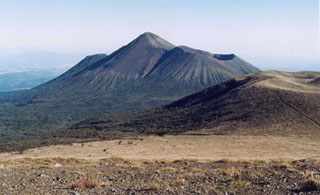Report on Kirishimayama (Japan) — 9 May-15 May 2018
Smithsonian Institution / US Geological Survey
Weekly Volcanic Activity Report, 9 May-15 May 2018
Managing Editor: Sally Sennert.
Please cite this report as:
Global Volcanism Program, 2018. Report on Kirishimayama (Japan) (Sennert, S, ed.). Weekly Volcanic Activity Report, 9 May-15 May 2018. Smithsonian Institution and US Geological Survey.
Kirishimayama
Japan
31.934°N, 130.862°E; summit elev. 1700 m
All times are local (unless otherwise noted)
JMA reported that at Shinmoedake (Shinmoe peak), a stratovolcano of the Kirishimayama volcano group, an eruption occurred between 1444 and 1610 on 14 May. The plume rose to 4.5 km (15,000 ft) above the crater and drifted SE. A pyroclastic flow travelled 2 km down the flank. Volcanic earthquake rates under the crater increased after the eruption. Shallow, low-frequency earthquakes and tremor were also reported. The Alert Level remained at 3 (on a scale of 1-5).
Geological Summary. Kirishimayama is a large group of more than 20 Quaternary volcanoes located north of Kagoshima Bay. The late-Pleistocene to Holocene dominantly andesitic group consists of stratovolcanoes, pyroclastic cones, maars, and underlying shield volcanoes located over an area of 20 x 30 km. The larger stratovolcanoes are scattered throughout the field, with the centrally located Karakunidake being the highest. Onamiike and Miike, the two largest maars, are located SW of Karakunidake and at its far eastern end, respectively. Holocene eruptions have been concentrated along an E-W line of vents from Miike to Ohachi, and at Shinmoedake to the NE. Frequent small-to-moderate explosive eruptions have been recorded since the 8th century.

